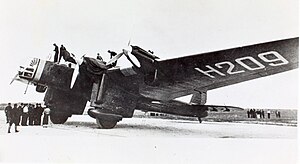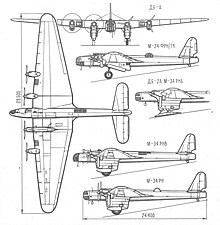Bolkhovitinov DB-A
| Bolkhovitinov DB-A | |
|---|---|
 Lewanewski's DB-A during the preparations for the long-haul flight |
|
| Type: | Heavy bomb plane |
| Design country: | |
| Manufacturer: |
Plant No. 124 Kazan |
| First flight: |
May 2, 1935 |
| Production time: |
1935-1938 |
| Number of pieces: |
12 |
The Bolchowitinow DB-A ( Russian Болховитинов ДБ-А ) was a heavy Soviet bomber and in this capacity one of the first types in the country to be manufactured in all-metal half-shell construction. The DB-A was supposed to replace the TB-3 bombers , which were already getting on in years, but in the end only twelve were built and a series production was abandoned in favor of the Pe-8 . When attempting a long-distance flight USSR - USA over the North Pole with a DB-A in 1937 , the machine disappeared over the Arctic without a trace .
history
The most prominent feature of the DB-A was the large pant leg landing gear fairings that ran out into the inner engine nacelles and into which the main wheels were retracted during the flight. Instead of the corrugated iron cladding that had been used on bomber planes up to that point , a sheet metal cladding was provided. In the leading edges of the thick wing there were two maintenance hatches next to each engine to make it easier for technicians to access the engines. All cabins showed glass panels and with a SchKAS - MG stocked Bugwaffenstand was using servo motors to move. In the hull of the huge middle-decker there were six meter long, closed bomb bays.
The first design work began in 1935 and was carried out by a team of specialists from the Zhukovsky Military Academy of the Air Force under the direction of Viktor Bolkhovitinov . The actual construction was in the hands of Mikhail Schischmarjow .
The type abbreviation DB-A stands for Dalni Bombardirowschtschik Akademija (Дальний Бомбардировщик Академия, long-range bomber of the academy (Zhukovsky)).
The DB-A prototype flew for the first time on May 2, 1935. The second model, the DB-2A took off for its first flight in March 1936 and had a higher take-off mass and a larger crew than the DB-A while maintaining the same top speed.
With these two aircraft various world records were flown in 1936/37: the two pilots M. Nyuchtikow and M. Lipkin brought a useful weight of 10,000 kg at an altitude of 7032 m and 13,000 kg at an altitude of 4535 m. Two other pilots, G. Baidukow and N. Kastanajew , flew on May 14, 1937 with 5000 kg payload over a distance of 2002.6 km at an average speed of 280 km / h.
After the flight tests were completed, an order was placed for a small series that was produced in 1937/38. Five of them went to the Soviet long-distance pilot , the rest were used for experiments or were in reserve.
Failed polar flight
In 1937 the polar aviator Sigismund Lewanewski attempted to make a long-distance flight between the USSR and the USA over the North Pole with a DB-A . Levanewski was one of seven pilots who received the title Hero of the Soviet Union in 1934 after the Cheliuskin team was saved .
As early as the spring of 1935, he asked Josef Stalin to be allowed to fly over the North Pole to San Francisco in an ANT-25 . Stalin gave his approval. Levanewski started on August 3, 1935 with copilot Baidukow to attempt a record, but broke it off over the Barents Sea because he mistakenly considered the oil tank, which was leaking due to overfilling, as an average. During the final evaluation of the flight, Levanewski described the designer Andrei Tupolew as a pest and a traitor and declared that he would never again want to fly in one of his aircraft.
In May 1937 he announced the decision to carry out the flight with the DB-A. Baidukov, who had already flown the plane, expressed his concerns about the machine, which had not yet been adequately tested, but was blocked by Stalin.
A short time later, an ANT-25 flew with Chkalov , Baidukow and Belyakov over the Pole to the USA, a month later a second with the crew of Gromov , Yumashev and Danilin . Levanewski came under time pressure. The six-person crew was put together in a hurry and did not have the time to get used to each other. A month before the flight, the radio operator Kerber was arrested in the course of the Stalinist purges and replaced by Galkowski .
On August 12, 1937, the prototype of the DB-A was ready at the Schcholkowo airfield near Moscow. The aircraft had been given a blue fuselage paint for the flight, the wing was painted signal red. Due to the unfavorable sign of the flight responded flight engineer Godowikow and navigator Levchenko the farewells of ground staff with "Farewell!" Instead of the usual "Goodbye!". The take-off was carried out by copilot Kastanajew .
After crossing the pole under poor weather conditions, the crew reported the failure of the right outer engine by radio after a flight time of 19:27 hours. After a while all radio contact broke off. Despite extensive searches by seven American and 24 Soviet aircraft, no trace of the DB-A with the aircraft registration SSSR N-209 could be found. In May 1938 the search was stopped after an area of 58,000 km² had been searched. The crew has been missing since then.
Technical specifications
| Parameter | Data (DB-A) | Data (DB-2A) | Data (DB-A) | |
|---|---|---|---|---|
| Constructors | M. M. Schischmarew, W. J. Bolchowitinow | |||
| Years of construction | 1936 | 1937 | 1938 | |
| crew | 8th | 11 | 5–8 (11?) | |
| length | 24.40 m | |||
| span | 39.50 m | |||
| height | 8.50 m | |||
| Wing area | 234.5 m² | |||
| Empty mass | 15,400 kg | 16,000 kg | ||
| payload | 6,500 kg | 8,000 kg | 6,000 kg | |
| Takeoff mass | 21,900 kg | 24,000 kg | 22,000 kg | |
| Wing loading | 95.2 kg / m² | 104.3 kg / m² | 95.7 kg / m² | |
| Power load | 7.68 kg / kW (5.64 kg / hp) | 6.80 kg / kW (5.00 kg / PS) | ||
| Ratio of usable / take-off mass |
29.7% | 33.3% | 27.3% | |
| Engines | four water-cooled twelve-cylinder - V engines | |||
| Type | M-34RN | M-34RNW | M-34FRN | |
| Starting power rated power |
713 kW (approx. 970 PS) each 618 kW (840 PS) each |
each 883 kW (approx. 1,200 PS) each 735 kW (approx. 1,000 PS) |
809 kW (1,100 hp) each 662 kW (900 hp) each |
|
| Top speed | 280 km / h near the ground 330 km / h at an altitude of 4,000 m |
305 km / h near the ground, 335 km / h at an altitude of 2,000 m |
300 km / h near the ground 316 km / h at an altitude of 6,000 m |
|
| Marching speed | 290 km / h at an altitude of 4,000 m | k. A. | k. A. | |
| Rise time | 5.0 min at 1,000 m 56.0 min at 7,000 m |
3.5 min at 1,000 m 34.0 min at 5,000 m |
3.5 min at 1,000 m 52.0 min at 7,000 m |
|
| Service ceiling | 7,220 m | 6,900 m | 7,730 m | |
| Range | 4,500 km | 4,600 km | 4,500 km | |
| Take-off / landing runway | 400 m / 300 m | 380 m / 300 m | 400 m / 300 m | |
| Armament (designed) |
four 7.62-mm-MG SchKAS with 3000 rounds each one 20-mm-MK SchWAK with 250 rounds up to 3,000 kg bombs |
|||
See also
literature
- Wilfried Copenhagen : Soviet bomb planes . Transpress, Berlin 1989, ISBN 3-344-00391-7 .
- Ulrich Unger: The transpolar flight S. A. Lewanewskis . In: Aviator Calendar of the GDR 1982 . Military Publishing House , Berlin 1981, p. 50-64 .
Web links
Individual evidence
- ↑ a b c Peter Korrell: TB-3 . The story of a bomber. Transpress, Berlin 1987, ISBN 3-344-00116-7 , pp. 180/181 .
